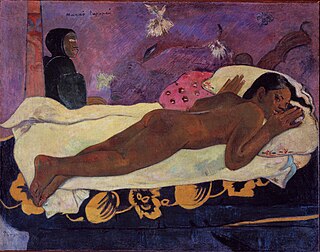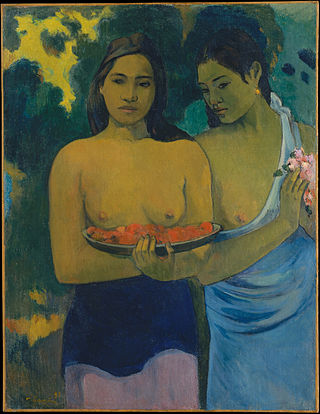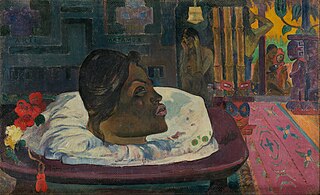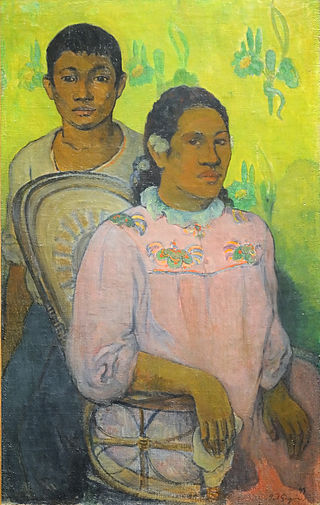
Eugène Henri Paul Gauguin was a French Post-Impressionist artist. Unappreciated until after his death, Gauguin is now recognized for his experimental use of colour and Synthetist style that were distinct from Impressionism. Toward the end of his life, he spent ten years in French Polynesia. The paintings from this time depict people or landscapes from that region.

Where Do We Come From? What Are We? Where Are We Going? is a painting by French artist Paul Gauguin. The painting was created in Tahiti, and is in the Museum of Fine Arts in Boston, Massachusetts. Viewed as a masterpiece by Gauguin, the painting is considered "a philosophical work comparable to the themes of the Gospels".

The Paul Gauguin Museum is a Japanese-styled art museum dedicated to the life and works of Paul Gauguin in Tahiti, French Polynesia. The Museum is closed for renovations - but the sister museum in Hiva Oa is open.

Oviri is an 1894 ceramic sculpture by the French artist Paul Gauguin. In Tahitian mythology, Oviri was the goddess of mourning and is shown with long pale hair and wild eyes, smothering a wolf with her feet while clutching a cub in her arms. Art historians have presented multiple interpretations—usually that Gauguin intended it as an epithet to reinforce his self-image as a "civilised savage". Tahitian goddesses of her era had passed from folk memory by 1894, yet Gauguin romanticises the island's past as he reaches towards more ancient sources, including an Assyrian relief of a "master of animals" type, and Majapahit mummies. Other possible influences include preserved skulls from the Marquesas Islands, figures found at Borobudur, and a 9th-century Mahayana Buddhist temple in central Java.

Spirit of the Dead Watching (Manao tupapau) is an 1892 oil on burlap canvas painting by Paul Gauguin, depicting a nude Tahitian girl lying on her stomach. An old woman is seated behind her. Gauguin said the title may refer to either the girl imagining the ghost, or the ghost imagining her.

Two Tahitian Women is an 1899 painting by Paul Gauguin. It depicts two topless women, one holding mango blossoms, on the Pacific Island of Tahiti. The painting is part of the permanent collection of the Metropolitan Museum of Art in New York City and was donated to the museum by William Church Osborn in 1949.

When Will You Marry? is an oil painting from 1892 by the French Post-Impressionist artist Paul Gauguin. On loan to the Kunstmuseum in Basel, Switzerland for nearly a half-century, it was sold privately by the family of Rudolf Staechelin to Sheikha Al-Mayassa bint Hamad Al-Thani, in February 2015 for close to US$210 million, one of the highest prices ever paid for a work of art. The painting was on exhibition at the Fondation Beyeler, Riehen, until 28 June 2015.

Nave Nave Mahana was made in 1896 by Paul Gauguin in Tahiti. It is kept in the Museum of Fine Arts of Lyon. The painting became part of the collections of the Lyon Museum in 1913.

Fatata te Miti is an 1892 oil painting by French artist Paul Gauguin, located in the National Gallery of Art, in Washington, DC.

Vahine no te vi is an 1892 painting by Paul Gauguin, currently in the collection of the Baltimore Museum of Art. It is one of the earliest of about seventy paintings he produced during his first visit to Tahiti and is one of many works of modern art in the museum's Cone Collection.

Merahi metua no Tehamana is an 1893 painting by the French artist Paul Gauguin, currently in the collection of the Art Institute of Chicago. The painting is a portrait of Paul Gauguin's wife Teha'amana during his first visit to Tahiti in 1891–1893. This marriage has always provoked controversy because it was arranged and completed in the course of a single afternoon and Gauguin claimed Teha'amana was just thirteen years old at the time.

Arii Matamoe or The Royal End is a painting on coarse cloth by the French artist Paul Gauguin, created in 1892 during the painter's first visit to Tahiti. It depicts a man's severed head on a pillow, displayed before mourners, and although it did not depict a common or contemporary Tahitian mourning ritual, may have been inspired by the death of Pōmare V in 1891 shortly after Gauguin's arrival. A curator for the J. Paul Getty Museum suggested Gauguin likely painted the canvas "to shock Parisians" upon his expected return to the city.

Aha Oe Feii? or Are You Jealous? is an oil-on-canvas painting by Paul Gauguin from 1892, based on a real-life episode during his stay on Tahiti which he later described in the diary Noa Noa: "On the shore two sisters are lying after bathing, in the graceful poses of resting animals; they speak of yesterday's love and tomorrow's conquests. The recollection causes them to quarrel, "What? Are you jealous?" Gauguin titled the painting in Tahitian language, Aha Oe Feii?, in the lower left corner of the canvas.
Today the term South Seas, or South Sea, is used in several contexts. Most commonly it refers to the portion of the Pacific Ocean south of the equator. In 1513, when Spanish conquistador Vasco Núñez de Balboa coined the term Mar del Sur, or South Sea, the term was applied to the entire area of today's Pacific Ocean. In 1520 Ferdinand Magellan named the same ocean the Pacific Ocean, and over time Magellan's name became dominant. The South Sea term was retained, but was applied only to southern areas of the Pacific.

Tahitian Woman and Boy is an 1899 painting by Paul Gauguin, now in the Norton Simon Museum, to which it was donated in 1976.

A Man with an Axe is an 1891 oil on canvas painting by Paul Gauguin, now in a Swiss private collection. It is one his first major paintings from his Tahiti period being painted shortly after his arrival in Papeete. A study for it is now in the Art Institute of Chicago.

Parau na te varaua ino is an 1892 oil on canvas painting by Paul Gauguin, produced during the artist's first stay on Tahiti. It is now in the National Gallery of Art

Nevermore is an 1897 oil on canvas painting by the French Post-Impressionist artist Paul Gauguin. Since 1932 it has been in the collection of the Courtauld Institute of Art and on display in the Gallery. It was executed during the artist's second stay on the island of Tahiti in the South Pacific.

Te Fare is an 1892 oil on canvas landscape painting by the French post-impressionist artist Paul Gauguin.


















